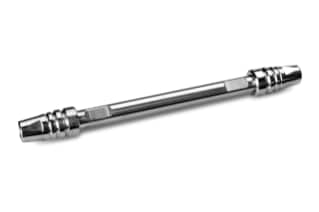
|
Chemistry |
PFP/Fluoro-Phenyl |
|
Separation Mode |
Reversed Phase |
|
Particle Substrate |
Hybrid |
|
pH Range Min |
1 pH |
|
pH Range Max |
8 pH |
|
Maximum Pressure |
6000 psi (415 Bar) |
|
Endcapped |
No |
|
Bonding Technology |
Fluoro-Phenyl |
|
Silanol Activity |
Low |
|
Particle Shape |
Spherical |
|
Particle Size |
3.5 µm |
|
Endfitting Type |
Waters |
|
Pore Size |
130 Å |
|
Format |
Column |
|
Surface Area |
185 |
|
System |
HPLC |
|
Particle Technology |
CSH |
|
USP Classification |
L43 |
|
Inner Diameter |
3 mm |
|
Length |
100 mm |
|
Carbon Load |
10 % |
|
UNSPSC |
41115709 |
|
Brand |
XSelect |
|
Product Type |
Columns |
|
Units per Package |
1 pk |

XSelect CSH Fluoro-Phenyl Column, 130Å, 3.5 µm, 3 mm X 100 mm, 1/pk
The XSelect CSH Fluoro-Phenyl column, which was created to increase selectivity differences, gives you the greatest amount of method development flexibility, particularly when utilizing low pH mobile phases. You can better retain acidic substances with the non-end-capped sorbent.
If you want the greatest amount of method development flexibility, especially when utilizing low pH mobile phases, add the XSelect CSH Fluoro-Phenyl Column to your lab. To optimize selectivity differences, it has been created. The column also offers superior performance and equal backpressure when compared to core-shell columns. Moreover, the loading capacity and particle size scalability of fully porous particle columns are enhanced by the XSelect CSH Fluoro-Phenyl Column.
By leveraging alternate selectivity through various column chemistries and procedures defining various pH scales, XSelect HPLC Columns facilitate the transition from analytical to preparative applications. Columns that maximize separation selectivity are among the best tools for changing chromatographic behavior. The broadly selective phases designed for contemporary UHPLC separations are redefined by the carefully chosen bonded ligands for the XSelect CSH XP and XSelect HSS XP Columns.
You can obtain results that are free of interference because all Waters XSelect CSH Fluoro-Phenyl Columns are created and handled using chemically inert materials to ensure there are no pollutants or impurities present. You can browse our website to shop for lab equipment your lab requires, or you can contact a member of our international support team for any help you may require.
You might also be interested in the Oasis Method Development 96-well µElution Plate, 2 mg Sorbent per Well, 30 µm, 1/pk; It has four Distinct mixed-mode, ion-exchange chemistries: strong and weak anion exchangers (MAX and WAX), as well as strong and weak cation exchangers, and comes with a unique 96-well plate structure with three rows of each (MCX and WCX). The creation of sample preparation methods can be completed fast and simply using just two SPE techniques. For automated, high throughput SPE, the Oasis Elution Sorbent Selection plate is compatible with the majority of liquid-handling robotic systems.
What Does The Word Mass Spectrometry Mean To Scientists?
In the field of chromatography, mass spectrometry, or MS as it is more commonly known, refers to the process of creating ions from organic or inorganic compounds using any appropriate methods, then separating the ions based on their mass-to-charge ratio so they can be measured and classified according to their concentration and mass-to-charge ratio.
Why Is Phenyl Called Benzene Instead?
Phene, which is still in use today, was the benzene ring's first chemical name. As a result, the "phenyl" group was used to describe this aromatic ring when it was joined to anything.